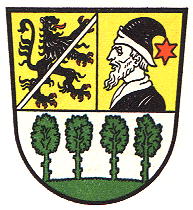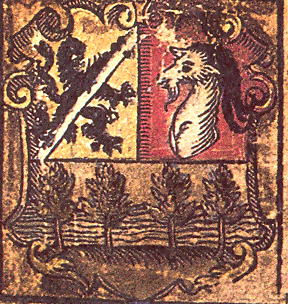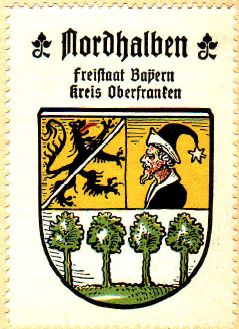Nordhalben: Difference between revisions
Knorrepoes (talk | contribs) m (Text replace - "[[Literature" to "{{media}} [[Literature") |
Knorrepoes (talk | contribs) m (Text replacement - "Additions :" to "Additions:") Tags: Mobile edit Mobile web edit |
||
| (29 intermediate revisions by the same user not shown) | |||
| Line 1: | Line 1: | ||
'''NORDHALBEN''' | '''NORDHALBEN''' | ||
State : [[Bayern]]<br/> | State : [[Bayern]]<br/> | ||
District (Kreis) : [[Kronach (kreis)|Kronach]]<br/> | District (Kreis) : [[Kronach (kreis)|Kronach]]<br/> | ||
Additions : 1978 [[Heinersberg]] | Additions: 1978 [[Heinersberg]] | ||
[[File:nordhalb.jpg|center]] | [[File:nordhalb.jpg|center|alt=Wappen von {{PAGENAME}}/Arms (crest) of {{PAGENAME}}]] | ||
= | {| class="wikitable" | ||
|+Official blazon | |||
|- | |||
|'''German''' | |||
| | |||
Geteilt und oben gespalten; oben vorne in Gold ein linksgewendeter, mit einer silbernen Schräglinksleiste überdeckter, rot bewehrter schwarzer Löwe; hinten in Gold der wachsende, schwarz gekleidete Rumpf eines bärtigen Mannes mit schwarzer Zipfelmütze, an deren Spitze ein sechsstrahliger roter Stern hängt; unten in Silber auf grünem Boden nebeneinander vier grüne Laubbäume. | Geteilt und oben gespalten; oben vorne in Gold ein linksgewendeter, mit einer silbernen Schräglinksleiste überdeckter, rot bewehrter schwarzer Löwe; hinten in Gold der wachsende, schwarz gekleidete Rumpf eines bärtigen Mannes mit schwarzer Zipfelmütze, an deren Spitze ein sechsstrahliger roter Stern hängt; unten in Silber auf grünem Boden nebeneinander vier grüne Laubbäume. | ||
|- | |||
|'''English''' | |||
| blazon wanted | |||
|} | |||
===Origin/meaning=== | |||
The oldest seal for the city was granted on January 11, 1518 by Georg Schenk von Limburg, Bishop of Bamberg, as the city at the time was a part of the State of Bamberg. | The oldest seal for the city was granted on January 11, 1518 by Georg Schenk von Limburg, Bishop of Bamberg, as the city at the time was a part of the State of Bamberg. | ||
The new seal showed a shield with in the upper half the lion of the State of Bamberg and a golden lion of [[Gera]], for the co-ruler of the city, Heinrich von Gera-Schleiz-Lobenstein. The lower half shows some trees, probably signifying the Frankenwald forests.As in 1567 the bishops acquired the full rule over the city, bishop Veit II von Würtzburg changed the arms. The lion of Gera was replaced by a male bust taken from the arms of von Würtzburg family. Under the rule of Bishop Philipp vol Gebsattel (1599-1609) the bust was changed to a silver goat's rump, taken from his family arms (see image below from 1603 from the Bamberger Vasallentafel). | The new seal showed a shield with in the upper half the lion of the State of Bamberg and a golden lion of [[Gera]], for the co-ruler of the city, Heinrich von Gera-Schleiz-Lobenstein. The lower half shows some trees, probably signifying the Frankenwald forests.As in 1567 the bishops acquired the full rule over the city, bishop Veit II von Würtzburg changed the arms. The lion of Gera was replaced by a male bust taken from the arms of von Würtzburg family. Under the rule of Bishop Philipp vol Gebsattel (1599-1609) the bust was changed to a silver goat's rump, taken from his family arms (see image below from 1603 from the Bamberger Vasallentafel). | ||
[[File:nordhalb2.jpg|center]] | [[File:nordhalb2.jpg|center|alt=Wappen von {{PAGENAME}}/Arms (crest) of {{PAGENAME}}]] | ||
In 1636 the new seal showed again the arms from 1567. These arms remained in use until 1819 when the lion of Bamberg had to be removed. The city had become part of Bayern in 1810 and all references to the old rulers had to be removed. The new seal of 1819 thus showed in the upper half the bust, and in the base the trees. These arms were officially confirmed in 1838. | In 1636 the new seal showed again the arms from 1567. These arms remained in use until 1819 when the lion of Bamberg had to be removed. The city had become part of Bayern in 1810 and all references to the old rulers had to be removed. The new seal of 1819 thus showed in the upper half the bust, and in the base the trees. These arms were officially confirmed in 1838. | ||
Later in the 19<sup>th</sup> century the city returned to the use of the arms of 1567, which were shown by Hupp in the late 1800s. | Later in the 19<sup>th</sup> century the city returned to the use of the arms of 1567, which were shown by [[Otto Hupp|Hupp]] in the late 1800s. | ||
{|align="center" | {|align="center" | ||
|align="center"|[[File:nordhalben.hagd.jpg|center]] <br/>The arms in the [[Kaffee Hag albums]] +/- 1925 | |align="center"|[[File:{{PAGENAME}}1892.jpg|center|Siegel von {{PAGENAME}}]] <br/>The municipal stamp shown in 1892 | ||
|align="center"|[[File:nordhalben.hagd.jpg|center|Wappen von {{PAGENAME}}/Coat of arms (crest) of {{PAGENAME}}]] <br/>The arms by [[Otto Hupp|Hupp]] in the [[Kaffee Hag albums]] +/- 1925 | |||
|} | |} | ||
[[Civic Heraldry Literature - Germany|'''Literature''']]: Stadler, 1990. | |||
{{de}} | |||
{{media}} | {{media}} | ||
[[Category:German Municipalities N]] | [[Category:German Municipalities N]] | ||
Latest revision as of 10:46, 28 January 2024
NORDHALBEN
State : Bayern
District (Kreis) : Kronach
Additions: 1978 Heinersberg
| German |
Geteilt und oben gespalten; oben vorne in Gold ein linksgewendeter, mit einer silbernen Schräglinksleiste überdeckter, rot bewehrter schwarzer Löwe; hinten in Gold der wachsende, schwarz gekleidete Rumpf eines bärtigen Mannes mit schwarzer Zipfelmütze, an deren Spitze ein sechsstrahliger roter Stern hängt; unten in Silber auf grünem Boden nebeneinander vier grüne Laubbäume. |
| English | blazon wanted |
Origin/meaning
The oldest seal for the city was granted on January 11, 1518 by Georg Schenk von Limburg, Bishop of Bamberg, as the city at the time was a part of the State of Bamberg.
The new seal showed a shield with in the upper half the lion of the State of Bamberg and a golden lion of Gera, for the co-ruler of the city, Heinrich von Gera-Schleiz-Lobenstein. The lower half shows some trees, probably signifying the Frankenwald forests.As in 1567 the bishops acquired the full rule over the city, bishop Veit II von Würtzburg changed the arms. The lion of Gera was replaced by a male bust taken from the arms of von Würtzburg family. Under the rule of Bishop Philipp vol Gebsattel (1599-1609) the bust was changed to a silver goat's rump, taken from his family arms (see image below from 1603 from the Bamberger Vasallentafel).
In 1636 the new seal showed again the arms from 1567. These arms remained in use until 1819 when the lion of Bamberg had to be removed. The city had become part of Bayern in 1810 and all references to the old rulers had to be removed. The new seal of 1819 thus showed in the upper half the bust, and in the base the trees. These arms were officially confirmed in 1838.
Later in the 19th century the city returned to the use of the arms of 1567, which were shown by Hupp in the late 1800s.
| The municipal stamp shown in 1892 |
The arms by Hupp in the Kaffee Hag albums +/- 1925 |
Literature: Stadler, 1990.
This page is part of the German heraldry portal Deutsche Wappensammlung |
Heraldry of the World |
|
German heraldry:
|
Selected collector's items from Germany:
|
Contact and Support
Partners:
Your logo here ?
Contact us
© since 1995, Heraldry of the World, Ralf Hartemink 
Index of the site















